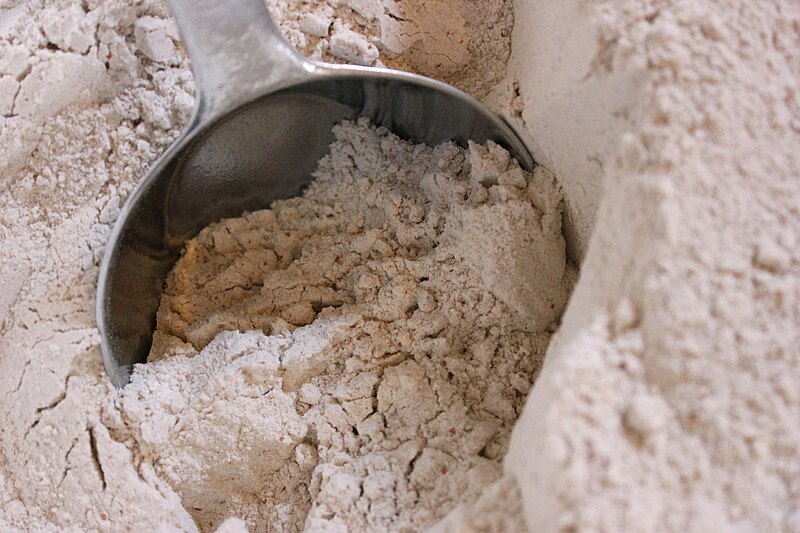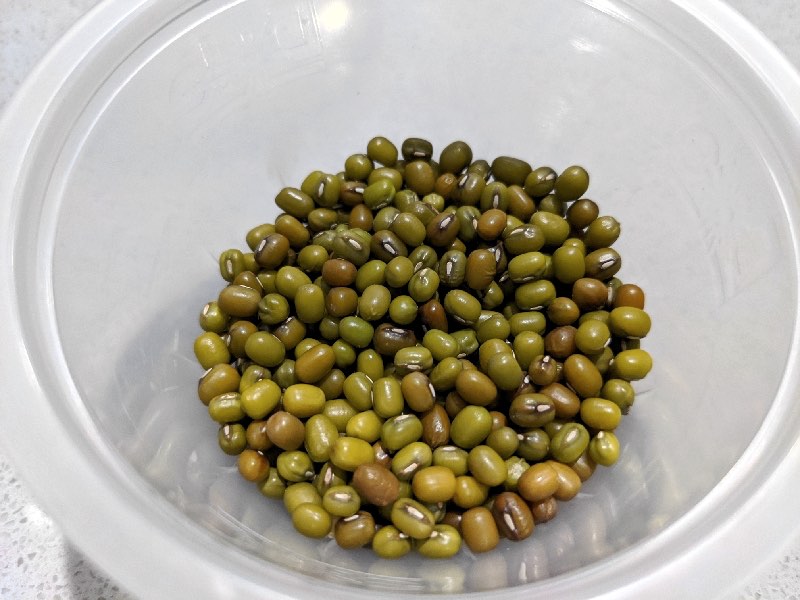Whole Wheat Flour vs. Mung Bean
Nutrition comparison of Whole Wheat Flour and Mung Bean
Ever wonder how your favorite foods stack up against each other in terms of nutrition?
We compared the nutritional contents of
whole wheat flour
versus
mung bean
(100g each)
below using 2020 USDA and NIH data[1].
For a quick recap of significant nutrients and differences in whole wheat flour and mung bean:
- Both whole wheat flour and mung bean are high in calories, carbohydrates, dietary fiber, iron, potassium and protein.
- Mung bean has more beta-carotene than whole wheat flour, however, whole wheat flour contains more lutein + zeaxanthin than mung bean.
- Mung bean has more thiamin and folate, however, whole wheat flour contains more niacin.
- Mung bean is an excellent source of calcium.
- Whole wheat flour has 5.4 times less sugar than mung bean.
USDA sources for nutritional information: Whole Wheat Flour (Wheat flour, whole-grain, soft wheat) and Mung Bean (Mung beans, mature seeds, raw) . Have a correction or suggestions? Shoot us an email.
Calories and Carbs
calories
Both whole wheat flour and mung bean are high in calories. Whole wheat flour is very similar to whole wheat flour for calories - whole wheat flour has 332 calories per 100 grams and mung bean has 347 calories.
For macronutrient ratios, whole wheat flour is lighter in protein, heavier in carbs and similar to mung bean for fat. Whole wheat flour has a macronutrient ratio of 11:84:5 and for mung bean, 27:70:3 for protein, carbohydrates and fat from calories.
Macro Ratios from Calories:
| Whole Wheat Flour | Mung Bean | |
|---|---|---|
| Protein | 11% | 27% |
| Carbohydrates | 84% | 70% |
| Fat | 5% | 3% |
| Alcohol | ~ | ~ |
carbohydrates
Both whole wheat flour and mung bean are high in carbohydrates. Whole wheat flour has 19% more carbohydrates than mung bean - whole wheat flour has 74.5g of total carbs per 100 grams and mung bean has 62.6g of carbohydrates.
dietary fiber
Both whole wheat flour and mung bean are high in dietary fiber. Mung bean has 24% more dietary fiber than whole wheat flour - whole wheat flour has 13.1g of dietary fiber per 100 grams and mung bean has 16.3g of dietary fiber.
sugar
Whole wheat flour has 5.4 times less sugar than mung bean - whole wheat flour has 1g of sugar per 100 grams and mung bean has 6.6g of sugar.
Protein
protein
Both whole wheat flour and mung bean are high in protein. Mung bean has 148% more protein than whole wheat flour - whole wheat flour has 9.6g of protein per 100 grams and mung bean has 23.9g of protein.
Fat
saturated fat
Both whole wheat flour and mung bean are low in saturated fat - whole wheat flour has 0.43g of saturated fat per 100 grams and mung bean has 0.35g of saturated fat.
Vitamins
Vitamin C
Mung bean has more Vitamin C than whole wheat flour - mung bean has 4.8mg of Vitamin C per 100 grams and whole wheat flour does not contain significant amounts.
Vitamin A
Mung bean has more Vitamin A than whole wheat flour - mung bean has 6ug of Vitamin A per 100 grams and whole wheat flour does not contain significant amounts.
Vitamin E
Whole wheat flour and mung bean contain similar amounts of Vitamin E - whole wheat flour has 0.53mg of Vitamin E per 100 grams and mung bean has 0.51mg of Vitamin E.
Vitamin K
Whole wheat flour and mung bean contain similar amounts of Vitamin K - whole wheat flour has 1.9ug of Vitamin K per 100 grams and mung bean has 9ug of Vitamin K.
The B Vitamins
Mung bean has more thiamin and folate, however, whole wheat flour contains more niacin. Both whole wheat flour and mung bean contain significant amounts of riboflavin, pantothenic acid and Vitamin B6.
| Whole Wheat Flour | Mung Bean | |
|---|---|---|
| Thiamin | 0.297 MG | 0.621 MG |
| Riboflavin | 0.188 MG | 0.233 MG |
| Niacin | 5.347 MG | 2.251 MG |
| Pantothenic acid | 1.011 MG | 1.91 MG |
| Vitamin B6 | 0.191 MG | 0.382 MG |
| Folate | 28 UG | 625 UG |
Minerals
calcium
Mung bean is an excellent source of calcium and it has 300% more calcium than whole wheat flour - whole wheat flour has 33mg of calcium per 100 grams and mung bean has 132mg of calcium.
iron
Both whole wheat flour and mung bean are high in iron. Mung bean has 82% more iron than whole wheat flour - whole wheat flour has 3.7mg of iron per 100 grams and mung bean has 6.7mg of iron.
potassium
Both whole wheat flour and mung bean are high in potassium. Mung bean has 216% more potassium than whole wheat flour - whole wheat flour has 394mg of potassium per 100 grams and mung bean has 1246mg of potassium.
Antioxidants and Phytonutrients
carotenoids
Carotenoids are micronutrients commonly found in plants and some animal products. An example is beta-carotene, the notable carotenoid which is a popular source of Vitamin A.[4][5]
For specific types of carotenoids, mung bean has more beta-carotene than whole wheat flour per 100 grams, however, whole wheat flour contains more lutein + zeaxanthin than mung bean per 100 grams.
| Whole Wheat Flour | Mung Bean | |
|---|---|---|
| beta-carotene | 5 UG | 68 UG |
| lutein + zeaxanthin | 220 UG | ~ |
Customize your serving size
The comparison below is by common portions, e.g. cups, packages. You can also see a more concrete comparison by weight at equal weight (by grams) comparison.
Note: The specific food items compared are: Whole Wheat Flour (Wheat flour, whole-grain, soft wheat) and Mung Bean (Mung beans, mature seeds, raw) .
Whole Wheat Flour 137g
(
cup
)
|
Daily Values (%) |
Mung Bean 207g
(
cup
)
|
|||||
|---|---|---|---|---|---|---|---|
| 455KCAL 23% |
|
5% | calories | 58% |
|
718KCAL 36% | |
| 102G 41% |
|
5% | carbohydrates | 27% |
|
130G 52% | |
| 18G 72% |
|
5% | dietary fiber | 89% |
|
34G 135% | |
| 1.4G | 5% | sugar | 900% | 14G | |||
| 2.7G 4% |
|
12% | total fat | 5% |
|
2.4G 4% | |
| 0.59G 3% |
|
5% | saturated fat | 22% |
|
0.72G 4% | |
| 0.39G | 18% | monounsaturated fat | 5% | 0.33G | |||
| 1.6G | 103% | polyunsaturated fat | 5% | 0.79G | |||
| 4.1MG 0.3% |
|
5% | sodium | 656% |
|
31MG 2% | |
| 5% | Vitamins and Minerals | 5% | |||||
|
|
5% | Vitamin A | >999% |
|
12UG 2% | ||
|
|
5% | Vitamin C | >999% |
|
9.9MG 13% | ||
| 45MG 5% |
|
5% | calcium | 507% |
|
273MG 27% | |
| 5.1MG 28% |
|
5% | iron | 175% |
|
14MG 78% | |
| 160MG 52% |
|
5% | magnesium | 144% |
|
391MG 126% | |
| 540MG 24% |
|
5% | potassium | 378% |
|
2579MG 112% | |
| 0.41MG 37% |
|
5% | thiamin (Vit B1) | 217% |
|
1.3MG 117% | |
| 0.26MG 23% |
|
5% | riboflavin (Vit B2) | 85% |
|
0.48MG 44% | |
| 7.3MG 52% |
|
55% | niacin (Vit B3) | 5% |
|
4.7MG 33% | |
| 0.26MG 20% |
|
5% | Vitamin B6 | 204% |
|
0.79MG 61% | |
| 1.4MG 28% |
|
5% | pantothenic acid (Vit B5) | 186% |
|
4MG 79% | |
| 38UG 10% |
|
5% | folate (Vit B9) | >999% |
|
1294UG 323% | |
| 0.73MG 5% |
|
5% | Vitamin E | 51% |
|
1.1MG 7% | |
| 2.6UG 3% |
|
5% | Vitamin K | 631% |
|
19UG 21% | |
| 13G 26% |
|
5% | protein | 277% |
|
49G 99% | |
| 43MG 10% |
|
5% | choline | 372% |
|
203MG 48% | |
| 0.65MG 54% |
|
5% | copper | 192% |
|
1.9MG 162% | |
| 4.7MG 259% |
|
124% | manganese | 5% |
|
2.1MG 119% | |
| 443MG 63% |
|
5% | phosphorus | 72% |
|
760MG 109% | |
| 17UG 32% |
|
5% | selenium | 5% |
|
17UG 31% | |
| 4.1MG 51% |
|
5% | zinc | 34% |
|
5.5MG 69% | |
| 17G | 5% | Water | 12% | 19G | |||
NO SIGNIFICANT AMOUNTS (either food): Starch, Alcohol, chlorine, chromium, fluoride, iodine, molybdenum, Vitamin D, biotin (Vit B7), Vitamin B12, cholesterol, trans fat. |
|||||||
FAQ
Does whole wheat flour or mung bean contain more calories in 100 grams?Both whole wheat flour and mung bean are high in calories. Whole wheat flour is quite similar to whole wheat flour for calories - whole wheat flour has 332 calories in 100g and mung bean has 347 calories.
Does whole wheat flour or mung bean have more carbohydrates?
By weight, both whole wheat flour and mung bean are high in carbohydrates. whole wheat flour has 20% more carbohydrates than mung bean - whole wheat flour has 74.5g of carbs for 100g and mung bean has 62.6g of carbohydrates.
Does whole wheat flour or mung bean contain more calcium?
Mung bean is a rich source of calcium and it has 300% more calcium than whole wheat flour - whole wheat flour has 33mg of calcium in 100 grams and mung bean has 132mg of calcium.
Does whole wheat flour or mung bean contain more iron?
Both whole wheat flour and mung bean are high in iron. Mung bean has 80% more iron than whole wheat flour - whole wheat flour has 3.7mg of iron in 100 grams and mung bean has 6.7mg of iron.
Does whole wheat flour or mung bean contain more potassium?
Both whole wheat flour and mung bean are high in potassium. Mung bean has 220% more potassium than whole wheat flour - whole wheat flour has 394mg of potassium in 100 grams and mung bean has 1246mg of potassium.

